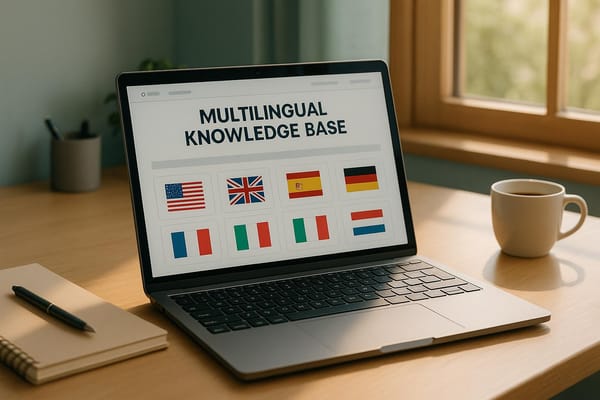AI Localization Workflow: Step-by-Step Guide
Learn how to streamline your AI localization workflow for effective multilingual content delivery with practical steps and strategies.

Want to deliver content in multiple languages effortlessly? AI localization combines machine learning with translation tools to help businesses create multilingual content that feels natural and accurate. Here's what you need to know:
- What It Does: AI localization translates and adapts content like knowledge base articles, chatbot responses, and user interfaces for different languages and regions.
- Why It Matters: It ensures faster responses, consistent messaging, and efficient resource use in customer support.
- How It Works: Automate translations with AI, refine them with human review, and manage everything from a single platform.
Key Steps to Set Up an AI Localization Workflow:
- Prepare Your Content: Write clear, structured material and keep your branding consistent.
- Use AI Tools: Set up translation tools with parameters like language pairs and data sources.
- Human Review: Check translations for accuracy and cultural relevance.
- Publish and Maintain: Deploy translations, monitor performance, and update content regularly.
Quick Tip: Tools like HelpJam simplify this process with integrated features for translating, managing, and publishing multilingual content. Whether you're starting with one language or scaling globally, AI localization can help you deliver consistent experiences across markets.
Setting Up Your AI Localization Workflow
Expanding on AI's role in customer support, creating an effective localization workflow is essential for delivering consistent experiences across global markets. With thoughtful planning, you can ensure smooth multilingual delivery. Tools like HelpJam, which offers a multilingual knowledge base and a fully translatable chatbox interface, can simplify this process and provide tailored support for your customers. Here's how to set up a localization workflow that works.
Content Types to Localize
When localizing with AI, focus on customer-facing content that directly shapes user experiences. Key areas include:
- Knowledge base articles for effective self-service
- AI chatbot responses for real-time interactions
- Help documentation and tutorials
- Product descriptions and feature lists
- User interface elements
- Customer communication templates
- Support ticket responses
Language Requirements
Identifying language needs starts with understanding your target audience and their preferences. Key considerations include:
| Consideration | Description | Impact |
|---|---|---|
| Market Demographics | Customer location and language choices | Focus on languages with the largest audiences |
| Content Format | Date, time, and number conventions | Use formats like MM/DD/YYYY and the 12-hour clock in the U.S. |
| Currency Display | Symbol placement and decimal format | Apply $XX.XX format for U.S. dollars |
| Measurement Units | Imperial vs. metric systems | Use miles, pounds, and Fahrenheit for U.S. users |
Content Preparation
Proper preparation is the foundation of a successful localization workflow. Focus on these steps:
- Optimize Source Content Write clear, concise material free of ambiguity and slang. Stick to simple sentence structures that are easy to translate. Use consistent terminology across all your documents.
- Organize Content Structure Arrange knowledge base articles with clear hierarchies and categories. This makes the translation process smoother and helps manage content across multiple languages.
- Maintain Brand Consistency Ensure that your branding - like domain names and visuals - remains consistent across all languages. This reinforces your identity while connecting with a global audience.
Preparing your content with these strategies ensures your localization efforts are efficient and scalable, meeting both technical demands and cultural expectations. This approach sets the stage for a workflow that grows with your business.
AI Localization Process Steps
Setting up an AI localization system involves combining automation with human expertise to achieve effective results.
Content Export and Organization
Start by organizing your content based on its type, priority, and target language. This ensures smooth processing by AI systems.
- Create Content Categories
- Group content into categories like knowledge base articles, customer support templates, UI elements, and product documentation.
- Track Content Status
- Keep tabs on document version updates and monitor the progress of translations.
- Set Up Content Tags
- Use tags to indicate priority levels, target languages, and content status.
Once the content is structured, move on to configuring AI translation tools.
AI Translation Setup
Set up AI translation tools using data from knowledge bases, PDFs, and web pages. Adjust parameters like GPT version, prompt settings, temperature, and rate limits to optimize the output.
| Setup Component | Focus Area | Purpose |
|---|---|---|
| Data Sources | Knowledge bases, PDFs, web pages | Ensures translations are context-aware |
| AI Parameters | GPT versions, prompts, temperature | Enhances translation precision |
| Rate Limits | API calls, processing speed | Balances workflow efficiency |
Human Review Process
After the AI generates translations, human reviewers step in to refine the content for cultural and contextual accuracy. Here's how:
- Initial Assessment
- Check translations for correctness while maintaining the brand's tone and relevance to the target audience.
- Cultural Adaptation
- Adjust translations to align with local customs, idioms, and preferences without losing the original intent.
- Technical Verification
- Confirm that technical details, such as measurements and formatting, are accurate for the target region.
Quality Checks
Run both automated and manual quality checks. Automated tools can catch spelling, grammar, and formatting errors, while manual reviews focus on context, brand voice, and cultural appropriateness. Once everything passes these checks, the content is ready for publishing.
Content Publishing
The final step is deploying the approved translations effectively.
- Synchronization
- Coordinate releases across all target languages, maintain version control, and update related content as needed.
- Distribution
- Publish content on the appropriate platforms, ensure accessibility, and monitor its initial performance.
- Maintenance
- Plan regular reviews to keep content up-to-date, refresh outdated material, and analyze engagement metrics to measure success.
Improving Your Localization Workflow
Workflow Automation
Automation can help cut down on manual tasks while maintaining high-quality translations. By connecting your CMS with translation tools using APIs and webhooks, you can streamline the process and save time.
Here’s how to make automation work for you:
- Set up API connections: Automatically send new content for translation as soon as it's created.
- Configure webhooks: Receive notifications when translations are completed and ready for use.
Performance Tracking
Tracking data is key to improving your localization process and ensuring your translations are effective. By monitoring specific metrics, you can identify what’s working and what needs adjustment.
| Metric | What to Track | Why It Matters |
|---|---|---|
| Search Patterns | Most searched terms by language | Highlights content gaps |
| Response Times | Average time to translate new content | Measures workflow efficiency |
| Customer Engagement | Article views and helpfulness ratings | Reflects translation quality |
| Resolution Rates | Support tickets resolved by language | Shows how effective content is |
Use analytics tools to assess the performance of your knowledge base. This will help you understand which translations resonate with your audience and guide your approach to adding or refining language support.
Adding New Languages
Adding more languages to your content requires strategic planning and resource management. Start by analyzing your audience and market needs to decide which languages to prioritize.
1. Evaluate Resource Needs
Determine the resources required for new languages. For instance, HelpJam offers plans like Starter ($49/month for 1 language), Growth ($99/month for up to 5 languages), and Business ($199/month for unlimited languages).
2. Develop a Content Plan
Focus on translating high-priority content first. This might include:
- Popular knowledge base articles
- Key customer support templates
- Essential product documentation
- User interface elements
3. Set Up AI Translation Tools
Use AI-powered translation tools to handle new language pairs efficiently. These tools can help maintain consistent terminology and integrate with your existing workflows for smooth operation.
Connecting Translation Tools
System Integration Methods
Integrating your translation tools with your CMS can simplify localization efforts. HelpJam provides API endpoints and webhook support to make this process smooth.
Here’s how you can connect:
- REST API Integration: Automate translation workflows by accessing content programmatically.
- Webhook Notifications: Get real-time updates for content changes or completed translations.
- Authentication: Secure your integration using API keys or OAuth.
Managing Content in One Place
Keeping everything centralized is key to maintaining consistency and control. HelpJam’s multilingual knowledge base allows you to manage translations efficiently:
- Version Control: Monitor changes across all language versions.
- Content Synchronization: Automatically identify outdated translations.
- Translation Memory: Ensure consistent terminology across your content.
HelpJam’s AI copilot also streamlines tasks like creating, translating, and rephrasing content - all within the same platform - reducing the need to switch between tools.
Integration Options
| Integration Type | Complexity | Real-Time Speed | Best For |
|---|---|---|---|
| Direct API | Technical | Immediate | Custom workflows |
| Webhook-based | Standard | Near immediate | Event-driven updates |
| Zapier (Coming Soon) | Basic | Scheduled | Non-technical teams |
If you’re just getting started, consider these steps:
- Start with one language pair and a small set of content to test the process.
- Measure how long translations take to complete and evaluate error rates.
- Document everything - API endpoints, webhook configurations, and any custom scripts.
HelpJam’s plans are designed to grow with your needs. The Starter plan ($49/month) supports single-language workflows, while the Business plan ($199/month) offers unlimited language support. These integration options make it easier to scale your localization efforts as your business expands.
Summary
Effective AI localization hinges on clear planning and the right tools. A well-structured approach ensures efficient management of multilingual content while maintaining consistent quality.
A winning strategy combines automated translation with human oversight. For example, HelpJam's AI co-pilot simplifies content creation and translation. Their multilingual knowledge base, available with the Business plan ($199/month), supports companies aiming for global expansion.
Here’s an overview of an optimized AI localization workflow:
| Phase | Key Components | Benefits |
|---|---|---|
| Content Preparation | AI-assisted writing and formatting | Speeds up content creation, ensures consistency |
| Translation | AI translation with human review | Delivers accurate, culturally relevant translations |
| Quality Assurance | Automated checks + expert review | Reduces errors, maintains brand consistency |
| Distribution | API-driven publishing | Enables smooth content deployment |
To refine your localization workflow, consider these tips:
- Use your content and style guides to train AI systems
- Set up clear review processes for translations
- Regularly monitor performance and make adjustments
- Expand language support as demand grows
HelpJam's platform streamlines this entire process by offering integrated tools for content management, translation, and deployment. Its AI-powered features ensure teams can efficiently create and translate content without compromising quality across languages.
FAQs
How do AI localization tools like HelpJam ensure translations are both accurate and culturally appropriate?
AI localization tools like HelpJam ensure translations are accurate and culturally appropriate by leveraging advanced technology to adapt content to the nuances of each language and culture. These tools go beyond direct translations, considering regional preferences, idiomatic expressions, and cultural sensitivities to create content that feels natural and engaging for local audiences.
With features like multilingual content management and customizable workflows, businesses can deliver seamless, personalized support to customers in their preferred language. This not only improves communication but also enhances the overall customer experience by fostering trust and understanding.
What factors should you consider when deciding which languages to localize content into?
When prioritizing languages for localization, consider key factors like your target audience and market demand. Start by analyzing where your customers are located and which languages they speak most frequently. This ensures your content resonates with the largest segments of your audience.
Additionally, assess the potential for business growth in specific regions. For example, emerging markets may offer opportunities for expansion if you localize effectively. Keep in mind cultural nuances and preferences to ensure your localized content feels natural and engaging to users in those regions.
Lastly, consider the costs and resources required for localization. Focus on languages that provide the highest return on investment while aligning with your overall business goals.
How does using translation tools with a CMS streamline localization workflows?
Integrating translation tools with a CMS significantly enhances the efficiency of localization workflows by automating repetitive tasks and maintaining content consistency across languages. It allows you to seamlessly manage multilingual content within a single platform, reducing manual effort and the risk of errors.
With features like automated content extraction, real-time updates, and translation memory, teams can save time and focus on delivering high-quality localized content. This streamlined process ensures faster turnaround times and improved scalability for global content management.





